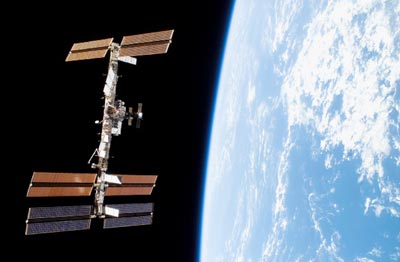The space station: the best of times, the worst of timesby Taylor Dinerman
|
| The US should, as a matter of principle, commit to keeping the station operational until at least 2020 or, even better, until 2025. |
NASA seems confident that it can repair the starboard Solar Array Rotary Joint (SARJ) in time to allow for the launch of the Kibo logistics module early next year. There are at least some spare parts already in orbit and the Atlantis STS-122 mission next month, or a Progress, might be able to bring up any small bits and pieces that would make the repair work easier. Fixing the SARJ is a good example of the kind of work that the ISS will require over the long term. Like any homeowner can tell you, any human habitation needs near constant repair and maintenance, the ISS is no different, except of course for its orbital altitude and 25,000 km/h speed.
The delicate set of relationships on which the ISS partnership is based presumes that, in the end, all parties will be able to get something they consider to be of value out of their investment. This means that the station should be operated for far longer than the current US budget guidance would seem to allow. In fact, NASA has been given clear guidance by the administration to do nothing that would jeopardize the use of the station beyond 2015.
This is not good enough. The US should, as a matter of principle, commit to keeping the station operational until at least 2020 or, even better, until 2025. This not only means that the US will have to pay its part to update basic elements of the ISS which are, after all, built around late-1980s or early-1990s technology, but that the US will have to negotiate with the international partners a utilization plan.
Any plan will have to be driven by more than just a desire to develop technologies for the Vision for Space Exploration. Commercial users such as SPACEHAB with its plans to manufacture protein crystals for the pharmaceutical industry will have to be accommodated, and experiments such as the proposed space solar power demonstration should be given a chance.
The biggest problem that NASA now faces is how to gain access to the ISS between the time the shuttle is retired in 2010 and the time the Orion capsule and Ares 1 rocket system is ready, which may be as late as 2015 or even later if NASA’s budget is further cut. Even if the space agency does get an extra $2 billion to accelerate work on the system it will still be at least 2013 at the earliest before NASA will have a way to send astronauts to the station on its own vehicles.
Will Russia maintain the agreement with the US to launch astronauts on the Soyuz system? The current (bad) state of relations between Washington and Moscow will make life difficult for any NASA official who wants to negotiate a deal for future Soyuz seats, and the fall in the value of the dollar does nothing to help matters. It was hard enough to get the US Congress to go along with a suspension of the Iran Nonproliferation Act (INA), which allowed the current deal to be concluded; a future deal may be held hostage to any number of extraneous events or policies.
The Europeans may, as expected, begin work on a program to turn their Automated Transport Vehicle (ATV), designed to carry cargo to the station and launched by the Ariane 5, into a human-rated capsule. Such a project, even if it were fully funded, would take many years to come to fruition and would certainly not be ready before 2015.
This leaves NASA with one realistic hope, Elon Musk and SpaceX’s Falcon 9 launcher/ Dragon capsule combination. While they have won over $270 million in money from the Commercial Orbital Transportation Services (COTS) project , that money was designed to develop a cargo-carrying system. To turn the cargo carrier into a fully certified human rated vehicle will probably take a lot more money than is currently available from NASA.
| The biggest problem that NASA now faces is how to gain access to the ISS between the time the shuttle is retired in 2010 and the time the Orion capsule and Ares 1 rocket system is ready. |
What make the situation even more precarious is the fact that SpaceX has not yet had a fully successful launch of its Falcon 1 rocket and, until that happens, NASA and others may be reluctant to commit to future SpaceX designs. If the next Falcon 1 flight test with a regeneratively cooled engine, now planned for early 2008, goes well, then the prospects for a second round of COTS funding for SpaceX will improve considerably.
In any case, NASA needs to begin looking at alternatives to Ares 1. The EELVs have established an excellent record and the successful Delta 4 Heavy launch this month shows that it has very nearly the 20-ton lift capability needed to get the Orion capsule into low Earth orbit.
Assuming NASA can solve the access problem, there are other challenges that NASA will have to overcome to keep the ISS running over the long haul. The next long-term problem is that the agency needs to find a way to ensure that the seals between the modules will remain safely intact for at least another decade or more. Beyond that, there will be a need to replace the current solar arrays with newer and more efficient ones.
The ISS is humanity’s one toehold in space. It can be used a real “world-class laboratory” or it can be allowed to spin around until, through lack of investment and high-level attention, it is deorbited like Russia’s Mir. That would be more than a tragedy; it would be a stupid waste.
